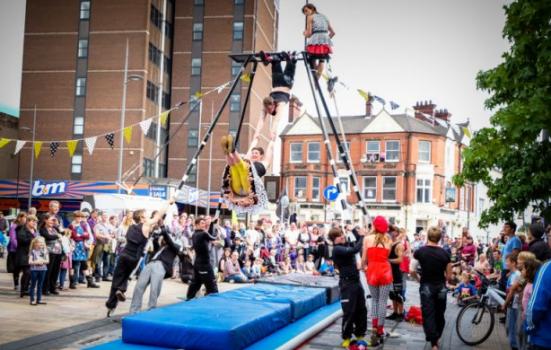Karl Greenwood on ways to help tourists discover a city from the inside out, tapping into local knowledge through technology and user-generated content.

Andrew Billington
“Do not ask yourself what is the cost of investing in culture. Ask yourself what is the cost of not investing in culture.” So said creative urbanist Charles Landry at a Culture Forum in Turin earlier this year.
Cultural tourism is big business. In 2011, 10 million in-bound visits to the UK involved engagement with the arts and culture, representing 32% of all visits and amounting to £7.6bn in tourism-related expenditure. The World Tourism Organisation reported in its study Tourism and Intangible Cultural Heritage 2012 that about 37% of all international trips include a cultural component.
Trawling through the endless number of definitions of cultural tourism, this one resonated the most: “Cultural tourism embraces the full range of experiences visitors can undertake to learn what makes a destination distinctive – its lifestyle, its heritage, its arts, its people – and the business of providing and interpreting that culture to visitors.” It goes back some way to a Creative Nation document from the Commonwealth Cultural Policy of 1994.
From culture vultures to accidental tourists, we no longer need to compromise on a one-size-fits-all approach to experience the cultural offer of a city
The definition highlights how we need to help people learn what makes a destination distinctive. But whose business is that? Who makes sense of the offer and tells the story of culture? ‘The Stoke-on-Trent story’ is a recent publication devised by a steering group of professionals. Stoke-on-Trent is the hero of the story, but culture promises to play a lead part by starring in two of the four identified themes: leisure and lifestyle, and celebrate ceramics. The story is not fictional, but outlines the city’s ambitions and shines a positive light on it to attract more investment and encourage more people to Stoke-on-Trent. Through my own experience of working on the Appetite programme in the city, there are many more Stoke-on-Trent stories unfolding that help to tell the cultural reality of the city.
It’s fair to say the cultural reality of Stoke-on-Trent is probably not what you read in cultural reports, the newspapers, tourism websites, or from the taxi drivers or results of searching ‘things to do in Stoke’ in Google. These sources may help paint a picture of the city but it doesn’t tell us everything. Stoke-on-Trent has seen dramatic changes at an astonishing rate over the past number of years with approximately £9m investment from Arts Council England feeding into the surrounding cultural eco-system. The Creative People and Places £3m programme (see the article in AP), led by Appetite at the New Vic Theatre, has inspired more people to experience the arts and produce their own cultural events. Then there’s Artcity which has revived derelict factories and spaces for cultural activity, the British Ceramics Biennial and new artist studios at the former Spode Works factory.
All this has breathed new life into the city’s cultural offer by broadening and strengthening the cultural portfolio. The more diverse and distinctive the portfolio, the more stories there are to tell and the more likely a place will succeed in attracting people to enjoy it as a cultural destination. The museums, theatres, all the large-scale, high-demand events and the smaller grassroots low-level events feed into the city’s cultural eco-system. But the city needs to do more to fly the flag so more people know about it.
The way we access information has shifted dramatically over the past number of years through the internet, mobile technology and digital platforms, giving more choice and alternative routes to finding out about and experiencing culture. We are increasingly looking to go where other tourists don’t tread – off the beaten track. Many of us want to see more than just the tick-box attractions. We want authentic experiences. Social media, locally led tourist websites and artist blogs can bring these everyday experiences to our attention much easier and faster these days.
It is not the business of the tourist information centre or any one funding stream or marketing strategy to cast a net over a place and tap into the real-time cultural pulse of everything that is happening. With user-generated content becoming one of the most used and trusted sources of information for tourists (approximately 35 million people use TripAdvisor each month), the voice of local people and punters is greater than ever before.
Musey, a US-based company, designed a mobile app using geo-technology to locate ephemeral art in their immediate vicinity. Even in New York, local people recognised that regardless of the millions of dollars being pumped into tourism, there was still a void in the existing cultural offer, in making the temporary, often invisible cultural activity more visible. Musey demonstrates how technology and a knowledge of users’ behaviours has tapped into the cultural reality of a place. It provides an inside-out view of a city that highlights the often hidden, unusual places and experiences you may not discover by yourself, defying the once conventional routes we have been accustomed to. From culture vultures to accidental tourists, we no longer need to compromise on a one-size-fits-all approach to experience the cultural offer of a city.
The digitisation of our lives provides us with more opportunities than ever before to learn from others and share our own experiences. The new live streaming site Periscope gives people instant access to the world in real time through the eyes of ordinary people.
At Appetite we are piloting a cultural reporter and ambassador scheme to explore how local people can be given the tools and opportunities to tell the stories of cultural activity in Stoke-on-Trent through journalism and advocating the arts with existing networks. These are just some of the fresh approaches that allow more people to discover and uncover a broader range of cultural activity in the places they live and visit.
Artist Joan Miro said: “The more local something is, the more it is universal.” Tourism starts at home in Stoke-on-Trent because it is the friendly charm of the place and its people that makes it distinctive and forms part of the city’s experience. The taxi drivers, hoteliers and shopkeepers are an integrated and integral part of the cultural landscape. Culture in Stoke-on-Trent should be everyone’s business and it needs a constant, coherent and collective approach to make the cultural reality of the city better known. Everyone in the city, from artists to town planners, should be the storytellers and interpreters of culture, working together to ensure that the city’s cultural reality is a jointly told tale.
Karl Greenwood is Project Director of Appetite.
www.appetitestoke.co.uk
Tw @karl_appetite
Tw @appetitestoke




